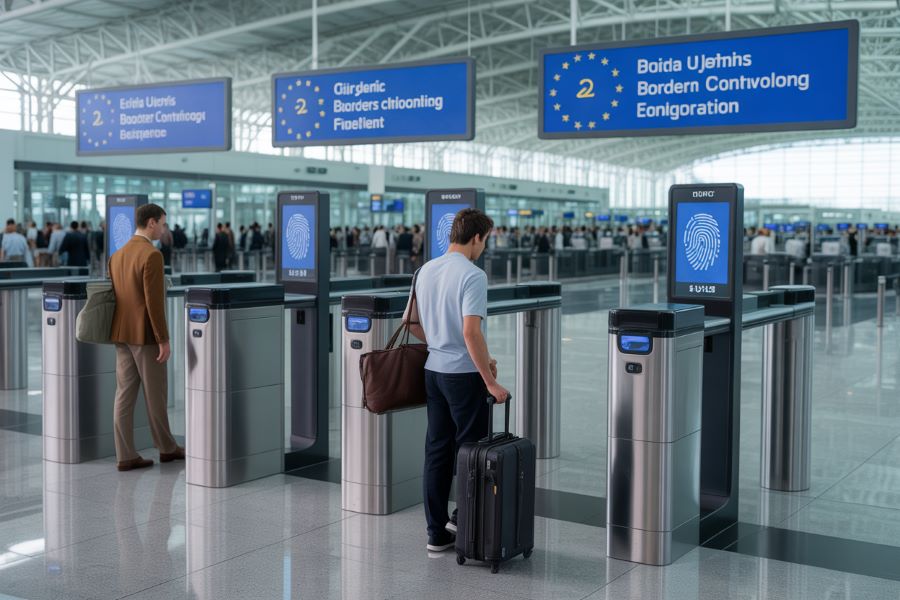Home » European Travel News » European Union Phases Out Passport Stamps: New Digital Entry/Exit System to Streamline Border Control- Here’s What You Should Know
Published on
August 9, 2025 |
Travelers heading to the European Union (EU) will soon face a major change in how their entry and exit are recorded. Beginnning from October 12, 2025, the EU will implement a new Entry/Exit System (EES), automating the border-crossing process for non-EU nationals visiting for short stays. This new system will phase out the traditional passport stamps that have long been a staple for travelers crossing EU borders.
The European Union aims to streamline the immigration process while enhancing border security through this advanced digital system. The system is set to be fully operational by April 10, 2026, after which travelers will no longer receive the familiar inked stamps in their passports.
How the EES Will Work: Biometric Data for Faster Border Checks
The EES will replace passport stamps with biometric data collection. Instead of the manual stamping process, travelers’ facial images and fingerprints will be scanned at the border to verify their entry and exit. This system will store biometric information securely for future reference, enhancing the efficiency of border controls and improving security within the Schengen Area.
EU authorities claim that this change will help streamline the border process, reducing waiting times and increasing the efficiency of border control staff. By automating the entry and exit data collection, the EU seeks to modernize and improve its security mechanisms, all while making the process faster and more reliable for travelers.
The Shift Toward Digital Border Controls: A Growing Global Trend
The shift to digital border control systems is part of a broader international trend. Australia was the first country to eliminate passport stamps, beginning this transition in 2012. Following in its footsteps, countries such as Argentina and Israel have also adopted digital entry and exit systems. Now, the EU is following suit, aiming to enhance border security while reducing human error and speeding up border checks.
This move is particularly relevant for travelers entering the Schengen Area, which includes 29 EU member states. Non-EU nationals will benefit from quicker border crossings as biometric data will be automatically linked to their travel records, making the process faster and less prone to mistakes.
EES and ETIAS: New Systems Changing Travel to Europe
While the EES will eliminate passport stamps, it is not the only new entry requirement for non-EU travelers to Europe. Starting in late 2026, the European Travel Information and Authorization System (ETIAS) will be introduced. ETIAS will require travelers to pay a fee of 20 euros and undergo a pre-screening process before entering the EU. ETIAS is intended to provide an additional layer of security by ensuring that all visitors are vetted before they even arrive at the border.
Together, the EES and ETIAS systems are expected to significantly improve border security while facilitating easier travel for legitimate visitors. The EES will focus on streamlining the entry and exit process, while ETIAS will ensure that travelers have been pre-approved for entry. These two systems will work in tandem to enhance the overall travel experience to Europe, while also addressing the EU’s concerns about security and border management.
Countries Phasing Out Passport Stamps in the EU
The new Entry/Exit System will be implemented across 29 EU countries, each of which will gradually replace the traditional passport stamp with the digital system. The countries included in this transition are:
- France
- Germany
- Spain
- Italy
- Portugal
- Netherlands
- Belgium
- Sweden
- Norway
- Finland
- Denmark
- Austria
- Switzerland
- Greece
- Hungary
- Poland
- Romania
- Bulgaria
- Croatia
- Slovakia
- Slovenia
- Czechia
- Estonia
- Latvia
- Lithuania
- Iceland
- Liechtenstein
- Luxembourg
- Malta
Travelers to these countries will be affected by the new system, with the EES fully operational by 2026. While this change may initially seem like a shift in the way people interact with immigration procedures, the aim is to make the travel experience more efficient and secure.
A Future of Seamless Border Crossing
The transition to digital border controls marks a significant step forward for the European Union. By leveraging technology to replace the manual stamping process, the EU is not only improving the efficiency of border checks but also setting a precedent for future travel systems around the world. For travelers, this means faster and more secure entry into Europe, and for the EU, it represents a proactive measure to safeguard its borders in an increasingly complex global landscape.
As the EES begins its rollout in October, travelers can expect more streamlined border crossings and the phasing out of the iconic passport stamp. The new system will help ensure that the Schengen Area remains a secure yet welcoming destination for international visitors. By embracing digital advancements, the EU is paving the way for a more efficient, secure, and modern travel experience.
